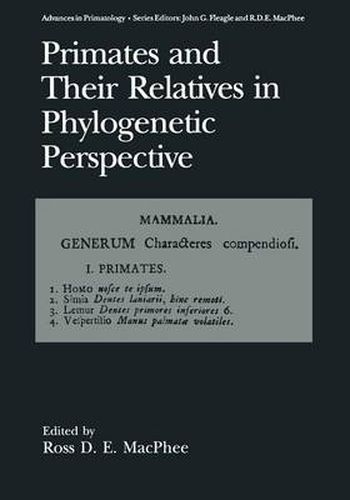Readings Newsletter
Become a Readings Member to make your shopping experience even easier.
Sign in or sign up for free!
You’re not far away from qualifying for FREE standard shipping within Australia
You’ve qualified for FREE standard shipping within Australia
The cart is loading…






This title is printed to order. This book may have been self-published. If so, we cannot guarantee the quality of the content. In the main most books will have gone through the editing process however some may not. We therefore suggest that you be aware of this before ordering this book. If in doubt check either the author or publisher’s details as we are unable to accept any returns unless they are faulty. Please contact us if you have any questions.
This book has the modest aim of bringing together methodological, theo- retical, and empirical studies that bear on the phylogenetic placement of primates and their relatives, and continues a tradition started by Phylogeny of the Primates: A Multidisciplinary Approach (edited by W. P. Luckett and F. S. Szalay; Plenum Press, 1975) and The Comparative Biology and Evolutionary Rela- tionships of Tree Shrews (edited by W. P. Luckett, Plenum Press, 1980). Although there are several recent compendia of studies of primate relationships, most of these are exclusively concerned with the internal arrangement of clades within the order, not with the place of primates and their relatives on the eutherian cladogram. Evolutionary theory predicts that primates must be more closely related to some non primate mammals than to others, but a continuing problem has been to find reliable procedures for recovering historical relationships among taxa. Before the 1970s, higher-level relationships among primates and euthe- rian mammals that might be closely related to them were rarely treated in detail. Outstanding exceptions, like Le Gros Clark’s Antecedents of Man, were just that-exceptions. (Clark himself essentially stopped with making a case for tree shrews; he did not, for example, explore whether bats and colugos were also related to primates. ) In the 1970s and 1980s, the rise of cladistic techniques and advances in molecular methods began to transform primate systematics.
$9.00 standard shipping within Australia
FREE standard shipping within Australia for orders over $100.00
Express & International shipping calculated at checkout
This title is printed to order. This book may have been self-published. If so, we cannot guarantee the quality of the content. In the main most books will have gone through the editing process however some may not. We therefore suggest that you be aware of this before ordering this book. If in doubt check either the author or publisher’s details as we are unable to accept any returns unless they are faulty. Please contact us if you have any questions.
This book has the modest aim of bringing together methodological, theo- retical, and empirical studies that bear on the phylogenetic placement of primates and their relatives, and continues a tradition started by Phylogeny of the Primates: A Multidisciplinary Approach (edited by W. P. Luckett and F. S. Szalay; Plenum Press, 1975) and The Comparative Biology and Evolutionary Rela- tionships of Tree Shrews (edited by W. P. Luckett, Plenum Press, 1980). Although there are several recent compendia of studies of primate relationships, most of these are exclusively concerned with the internal arrangement of clades within the order, not with the place of primates and their relatives on the eutherian cladogram. Evolutionary theory predicts that primates must be more closely related to some non primate mammals than to others, but a continuing problem has been to find reliable procedures for recovering historical relationships among taxa. Before the 1970s, higher-level relationships among primates and euthe- rian mammals that might be closely related to them were rarely treated in detail. Outstanding exceptions, like Le Gros Clark’s Antecedents of Man, were just that-exceptions. (Clark himself essentially stopped with making a case for tree shrews; he did not, for example, explore whether bats and colugos were also related to primates. ) In the 1970s and 1980s, the rise of cladistic techniques and advances in molecular methods began to transform primate systematics.